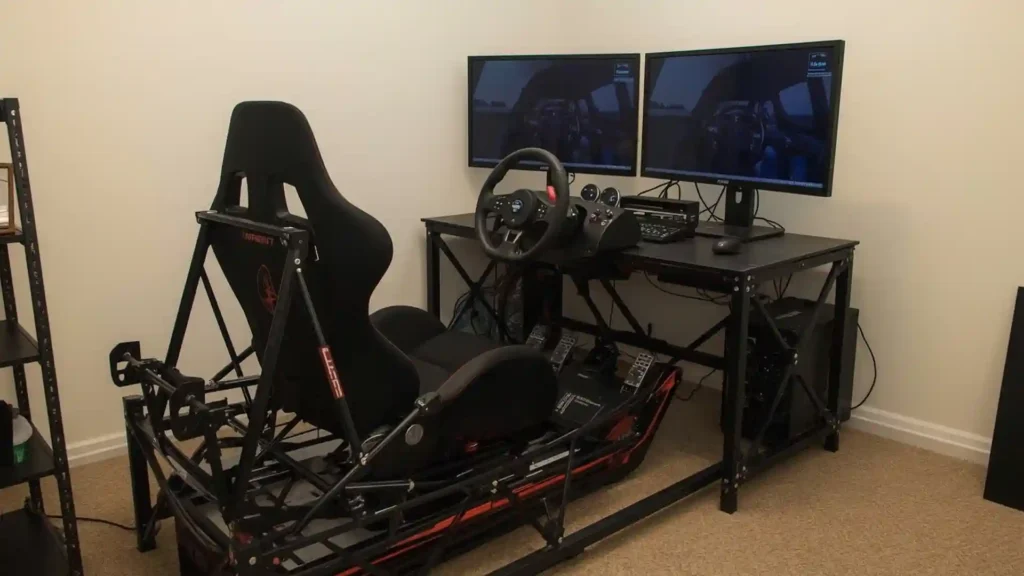
Desk vs Rig: What’s Better for Beginners in Racing Simulator?
Now that you are familiar with building your first racing simulator journey, you have to make another choice between two options; desk vs rig. Picking between a desk setup and a dedicated rig is one of your first big decisions.
You can compare a desk and rig to riding a bicycle or driving a car. Both have the same purpose, but the experience is completely different.
A desk setup is like a bicycle: simple, affordable, and perfect for getting started. Whereas, a rig, on the other hand, is like having your own race car: more realistic, immersive, and built specifically for racing simulator.
But here’s the thing: everyone can have a different opinion. What works perfectly for you, desk vs rig, might not work for others. Your budget, available space, and how serious you are about racing plays important role in this decision.
Both desk vs rig racing simulator setups have clear winners and losers in different categories. Some beginners love the flexibility of a desk setup, while others can’t imagine racing without a proper rig’s stability and realism.
Gaming Tech Series will break down everything you need to know to make the perfect choice for your racing simulator adventure.
What is a Desk Setup?
A desk setup is turning your computer desk into a racing simulator platform. It’s the easiest way to build your racing simulator i.e., using your existing furniture for your racing gear.
You’ll clamp your steering wheel directly onto your desk edge, place pedals on the floor underneath, and use your regular office chair or gaming chair for seating. It’s like transforming your homework station into a race car cockpit in just a few minutes.

Most beginners start with simple gear: a beginner-friendly racing wheel (like the Logitech G29), a basic two or three-pedal set, and whatever chair they already own. You can get started with a complete desk setup for anywhere from $200 to $500, making it the cheapest entry point into sim racing.
This setup works best for beginners, racers on a budget, people with limited space (like small bedrooms or shared family rooms), and anyone who wants to test the waters before diving deeper into the hobby.
Pros & Cons
| Pros | Cons |
| Very affordable | Wheel and desk can shake during intense racing |
| Quick and easy setup | Difficulty in finding the correct seating position |
| Takes less space | Doesn’t feel as realistic as a real race car |
| Uses furniture you already have | Pedals might slide around on smooth floors |
What is a Racing Rig Setup?
A racing rig is a dedicated frame designed to hold all your racing simulator equipment. It can be made up of metal or wood. Think of it as building your own race car that stays in one spot. Instead of clamping, all the components are bolted together into one solid unit.
Racing rigs come in several types to fit different needs and budgets. Entry-level rigs are basic frames that hold your wheel, pedals, and seat, with more stability than a desk. Foldable rigs can be stored away when not in use, great for shared spaces. Full cockpit setups mimic real race cars completely, with everything positioned exactly like you’d find in a Formula 1 car or NASCAR vehicle.

You’ll typically spend anywhere from $300 for a basic rig up to $2,000+ for premium cockpit setups. The price depends on materials, adjustability features, and how realistic you want the experience to feel.
Racing rigs work best for serious sim racers who plan to spend lots of time racing, anyone wanting the most realistic experience possible, and people who have dedicated space for their setup.
Pros & Cons
| Pros | Cons |
| Solid stability during intense racing | Much more expensive |
| Feels much more like driving a real race car | Takes up significant room space |
| Everything adjusts to fit your body perfectly | Assembly can take several hours |
| Built to last for years | Hard to move once set up |
Comparison Table: Desk vs Rig
| Factor | Desk Setup | Racing Rig |
| Cost | $200–$600 | $500–$1500+ |
| Space Needed | Uses existing table | Requires dedicated space |
| Setup Time | 5–10 minutes | 2–4 hours |
| Stability | Wobbly under pressure | Rock-solid mounting |
| Comfort | Office chair; not ideal ergonomics | Racing seat; great for long sessions |
| Realistic | Feels like gaming | Feels like real racing |
| Flexibility | Can be removed easily | Fixed setup |
| Upgrade Path | Limited upgrade potential | Fully modular and upgradable |
| Endurance | Uncomfortable for long sessions | Comfortable for hours |
| Best For | Beginners, casual racers, small spaces | Enthusiasts, serious racers, realism |
The Wise Choice: Desk vs Rig

The best choice will be the informed decision. Let’s divide consumers into 2 categories;
- On a budget, but no compromise on experience.
- No need to worry about budget, spend recklessly.
So, if you are on a budget, it’s better to opt for a desk setup, as you can upgrade your racing simulator anytime. Similarly, if you don’t have to worry about budget, you can go for a racing rig. And, in the case of being a beginner racer, it’s better to start with a desk setup so you can later make a professional racing simulator.
Also, if you are a beginner, try to avoid these mistakes when setting up your racing simulator.
FAQs: Choosing Between Desk vs Rig
- Is a racing rig necessary for beginners in sim racing?
A: Not at all. Many newcomers begin with a simple desk-mounted wheel and basic pedals. A desk setup is affordable, fast to install, and perfect for testing the waters before committing to a full rig. - What are the main benefits of starting with a desk setup?
A: Desk setups are compact, cost-effective, and easy to assemble. You can use your existing workspace, which makes it ideal for small rooms or shared living spaces. - What are the limitations of using a desk setup for sim racing?
A: Desk-mounted wheels can feel unstable during intense races. Pedals might slide, and the lack of a proper racing seat can lead to discomfort during longer sessions. - When should I upgrade from a desk to a racing rig?
A: Upgrade when you’re ready for more immersion, improved comfort, and better control. A rig becomes essential if you’re using heavy-duty hardware like a direct drive wheel or load cell pedals. - Can I use my racing rig for both work and gaming?
A: While possible, it’s not ideal. Some rigs can double as a desk with attachments, but they often lack the flexibility and comfort of a dedicated workstation. A hybrid setup may work, but expect compromises. - Are foldable or compact rigs a good alternative to desk setups?
A: Yes. Foldable sim racing rigs, like the Playseat Challenge, strike a balance between portability and improved stability. They’re great for beginners with limited space who want a more realistic racing experience. - Will a desk setup restrict my ability to upgrade sim racing gear?
A: Eventually, yes. While a desk works for entry-level gear, it can struggle to support high-torque wheels, robust pedal sets, or gear shifters, limiting your potential as you advance in the hobby. - Can I be competitive in sim racing with just a desk setup?
A: Definitely. Many top sim racers started with a desk. With skill and consistency, you can achieve great lap times. A rig adds comfort and realism, but performance is still possible without it.
